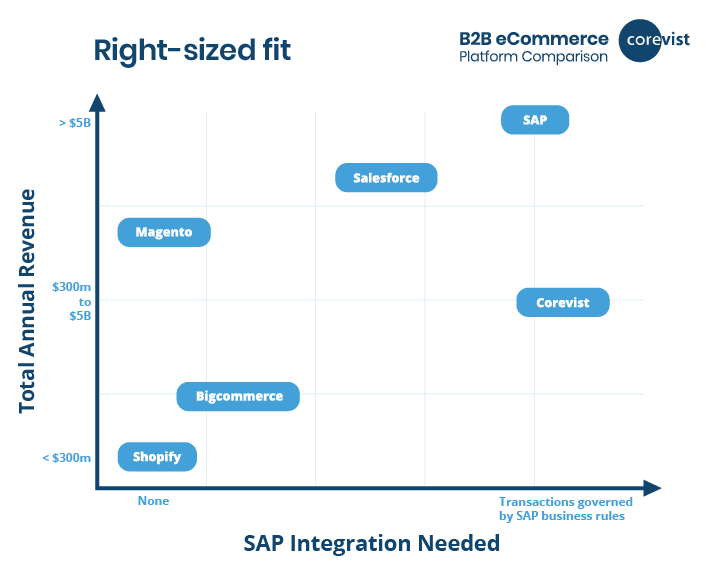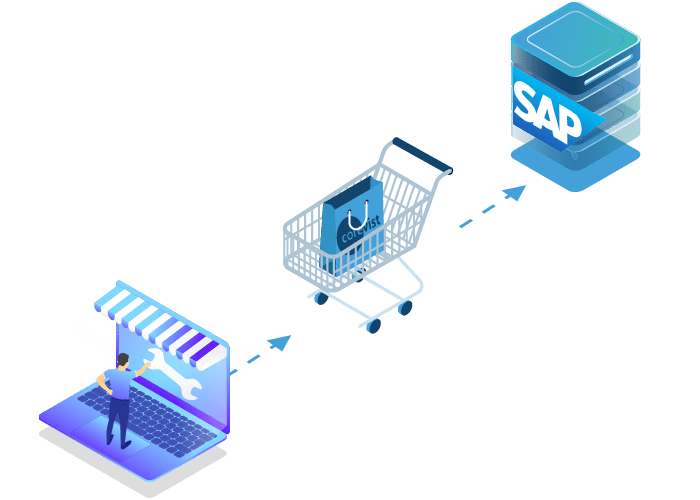Hybris is a great choice
for large organizations.
Yet not every manufacturer can justify the cost and complexity.
Use your company’s total annual revenue, plus ERP integration
required, to determine your best-fit hybris alternative.

SAP hybris alternatives: A deeper dive
Learn more about the hybris alternatives which are best suited to your company.
Click on the bracket that matches your organization:
Hybris alternatives for companies with <$300M total annual revenue
Hybris alternatives for companies with $300M – $5B total annual revenue
Hybris alternatives for companies with >$5B total anual revenue
1. Hybris alternatives for organizations with <$300M in total annual revenue

If you’re a small business, the complexity of an enterprise-class hybris alternative like Salesforce may be hard to justify. In this revenue bracket, you should prioritize a great user experience, readily available frontend widgets, prebuilt connectors to other systems, and an eCommerce technology stack managed by the vendor rather than by you.
For this revenue bracket, Bigcommerce and Shopify are great alternatives to SAP hybris/Commerce Cloud.
For organizations with <$300M/year total revenue, Magento can be a great hybris alternative. There’s only one caveat: Magento is a PaaS (platform as a service) solution, rather than SaaS (software as a service). To build out, maintain, and support your solution, you’ll need to hire Magento developers, either in-house or through a third party.
2. Hybris alternatives for organizations with $300M – $5B in total annual revenue

In this revenue bracket, your choices in hybris competitors begin to diverge. When it comes to eCommerce requirements, most companies fall into two major buckets:
- You just need a beautiful B2C-style front end, and you don’t require any SAP ERP integration for B2B.
- Your entire business lives in SAP ERP, including personalized B2B business rules, and the eCommerce experience must conform to those busines rules 100%.
Let’s unpack those.
You need a beautiful B2C-style front end, no SAP ERP integration required
If you’re primarily looking for a great B2C-style experience, Adobe/Magento is a great alternative to hybris. The solution offers everything you need to compete online (as long as you don’t need deep integration to SAP ERP) .
Magento offers more control than Shopify or Bigcommerce—but with that control, you’ll also take on more responsibility. Building, integrating, launching, maintaining, and supporting your solution will require a team of Magento developers, either in-house or outsourced.
You’re probably wondering: Aren’t Magento and Salesforce competing for the same market? They are, and you’ll see that fact reflected in their costs. You’ll spend roughly $500k/year for either of these hybris competitors.
For organizations in this revenue bracket, Magento comes with one caveat: While its overall cost is similar to Salesforce, it’s only eCommerce. In addition to eCommerce, Salesforce also offers their powerful, flexible CRM platform.
Your transactions live and die by SAP business rules
You can achieve deep SAP ERP integration with any hybris alternative—whether Magento, Salesforce, or SAP hybris/Commerce Cloud itself. There’s only one problem: The cost of scoping, building, and maintaining that integration isn’t trivial, because none of these platforms was built to integrate deeply with SAP ERP.
You’ll have 3 separate software systems (ERP, middleware, and eCommerce), and each one will require its own team to support:

For organizations in the $300M – $5B revenue bracket, building and maintaining a custom integration to SAP ERP often becomes too costly and difficult.
Corevist was built to address this problem. Our solutions include prebuilt, configurable, real-time SAP integration covering every aspect of the user’s journey.

The Corevist Platform provides a personalized user experience driven by the customer’s unique business rules in SAP—all without requiring a 3rd party to maintain the integration:
- 100% accurate real-time inventory availability/personalized ATP calculation
- Dynamic, 100% accurate contract pricing
- 100% accurate real-time credit status
- 100% accurate order status PLUS order history from all channels (EDI, phone, fax, email, eCommerce, etc.)
- 100% accurate invoice history/status PLUS capability to pay down invoices through self-service
A hybris alternative with a net efficiency gain:
Corevist’s built-in SAP integration is unique among hybris alternatives. Because our integration is direct and real-time, we eliminate the cost, complexity, and liability of a system or process sitting between eCommerce and SAP ERP. This reduces your cost to serve and ensures your eCommerce experience is always 100% accurate, for each and every customer.

3. Hybris alternatives for organizations with > $5B in total annual revenue

If you can budget $800k+ for a fully customized frontend solution (plus additional outlay for a bespoke integration to SAP ERP), then both Salesforce and SAP Commerce Cloud/hybris offer excellent options. They’re both true enterprise-class solutions, offering best-in-class, B2C-style experiences with a large capacity for front-end flexibility.
With both SAP hybris and Salesforce, you license the platform, then hire dedicated resources to construct your solution using the appropriate functionality available in the platform. This path gives you the greatest power over your solution.
Of course, greater control means you also have to take more ownership of the technology stack. For both SAP hybris and Salesforce, implementations often total over a million dollars. After launch, each one will require a dedicated team to support the solution.
The Bottom Line: Best Alternatives to SAP Hybris
Here’s the best fit for companies in different total revenue brackets:
- <$300M: Shopify, Bigcommerce
- $300M – $5B: Magento for B2C, Corevist for SAP-integrated B2B
- >$5B: SAP Commerce Cloud or Salesforce

